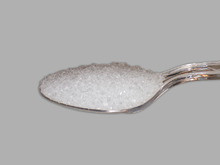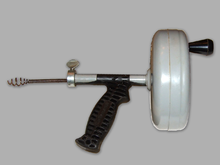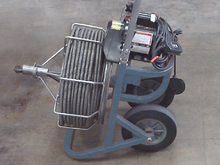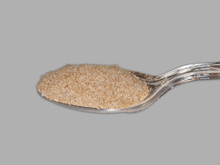- Drain cleaner
-
A drain cleaner is a consumer product or device that unblocks sewer pipes or helps to prevent the occurrence of clogged drains; the term may also refer to the individual who performs the activity. Drain cleaners can be classified in three categories, according to their intended use.
- If a single sink, toilet, or tub or shower drain is clogged the first choice is normally a drain cleaner that can remove soft obstructions such as hair and grease clogs that can accumulate close to interior drain openings. Chemical drain cleaners, plungers, handheld drain augers, air burst drain cleaners, and home remedy drain cleaners are intended for this purpose.
- If more than one plumbing fixture is clogged the first choice is normally a drain cleaner that can remove soft or hard obstructions along the entire length of the drain, from the drain opening through the main sewer drain to the lateral piping outside the building. Electric drain cleaners and sewer jetters are intended for this purpose.
- When performing preventative drain cleaning to reduce the future occurrence of clogs, enzymatic drain cleaners and sewer jetters are normally used.
Each type of drain cleaner has advantages, disadvantages, and safety considerations as described below.
Contents
Chemical drain cleaners
Chemical drain cleaners include liquid and solid corrosive drain cleaners that are readily available through retail stores, as well as acid drain cleaners that are intended primarily for use by licensed plumbers.
Liquid formulations of corrosive drain cleaners can contain sodium hypochlorite NaOCl (bleach), sodium hydroxide (lye), or potassium hydroxide (caustic potash) in concentrations up to 50 percent. Other corrosive mixtures come as two-part cleaners that are mixed as they are poured in the drain opening. Inside the drain the two solutions react to release a gas, and surfactants trap the gas as dense foam. The intent of this foaming action is to coat the inside of the drain pipe to dislodge more of the substances that form the clog.
Solid formulations of corrosive drain cleaners in the form of sodium hydroxide or potassium hydroxide granules can provide more concentrated effective ingredients. Some patented, solid-formula cleaners add aluminum turnings that react with to the solid hydroxide in water to heat the caustic mixture to a boil.
Acid drain cleaners based on concentrated Sulphuric Acid,(c 80% strength) are intended primarily for use by licensed plumbers because of safety considerations. According to one manufacturer, potential hazards include violent reaction with water and the production of explosive hydrogen vapors upon contact with most metals; chronic (delayed) and acute (immediate) health hazards if inhaled, ingested, or contacted by skin including severe eye and skin burns, inflammation of respiratory membranes, and corrosive burns to all human tissue; permanent visual loss upon contact with eyes; and death if swallowed.[1]
Advantages of chemical drain cleaners include ready availability of some formulations through retailer stores and potential ease of use for removing soft hair and grease clogs that accumulate close to drain openings.
Disadvantages of chemical drain cleaners include a lack of effectiveness for removing clogs far from the drain opening (for example, clogs that occur in toilets[2] or in the main sewer drain), an inability to remove most solid obstructions, and the safety considerations outlined below.
Safety considerations for chemical drain cleaners, the danger arises from their potential to injure eyes, lungs and skin and damage to clothing and household materials such as wood, paint, aluminum and fiberglass. Chemical drain cleaners should be used only according to the manufacturer's instructions, as other use may cause injury.[3] Strongly corrosive and acid drain cleaners are among the most hazardous household products available to the public.
Handheld drain augers
Handheld drain augers are typically designed to clean portions of a drain within 8 metres (25 ft) of the drain opening. The cable of a handheld drain auger is driven into a drain by the mechanical force created when the operator rotates a drum that anchors the cable.
Many handheld augers have cables that are thin enough to pass through common sink traps, though some manufacturers do not recommend using handheld drain augers in toilets[4] because of their potential to scratch ceramic surfaces.
Advantages of handheld drain augers include low relative cost and ready availability through hardware stores.
Disadvantages include a reach that is normally limited to 8 metres (25 ft), and the potential for the twisting cable to scratch the ceramic surfaces of plumbing fixtures. They are also only effective on small diameter pipes - 40-50mm rather than main sewer pipes of 110mm.
Safety considerations include a requirement to wear protective gloves and eye protection, and to practice good hygiene after coming into contact with drain fluids.[4]
Air burst drain cleaners
Air burst drain cleaners use accelerated carbon dioxide, air or other gas to rupture the clog membrane. Accelerated gas creates a force on standing water that can dislodge clogs that accumulate close to drain openings.
Advantages of air burst drain cleaners include the potential to immediately clear clogs and slow-running drains, in contrast to chemical cleaners that can take more time to work. Air burst cleaners can dislodge obstructions that are further away from drain openings than can a plunger, and in contrast to a drain augers do not risk scratching the ceramic surfaces of sinks, bathtubs and toilets.
Disadvantages of air burst drain cleaners include a limited cleaning range in pipes that do not contain standing water and, in general, ineffectiveness for unclogging blocked main sewer drains.
Safety considerations for air burst drain cleaners include a requirement to wear eye protection and, when using an air burst cleaner that uses compressed gas cartridges, careful handling of unused cartridges.[5]
Home remedy drain cleaners
Home remedy drain cleaners include boiling water poured into drain openings to clear soap and hair clogs; or, baking soda (sodium bicarbonate) poured into a drain, followed by vinegar.[6]
Advantages of home remedy drain cleaners include ready availability and environmental safety.
Disadvantages include limited effectiveness compared to other drain cleaners.
Safety considerations for home remedy drain cleaners include the requirement to handle ingredients (for example, boiling water) with the appropriate care.
Electric drain cleaners
Electric drain cleaners, also called plumber's snakes, use the mechanical force of an electric motor to twist a flexible cable or spring in a clockwise direction and drive it into a pipe. Electric drain cleaners are commonly available with cable lengths of up to 40 metres and can go as far as 80 metres.(125 ft).
Advantages of electric drain cleaners include the ability to clean long sections of sewer drain, the ability to remove solid objects such as tree roots and jewelry, and ready availability through hardware stores and tool rental counters. Machines using springs can easily negotiate multiple 90 degree bends while maintaining their effectiveness and without damaging the pipe.
Disadvantages of electric drain cleaners include high relative cost and weight, and the considerable physical effort that may be required to control the cable.
Safety considerations for electric drain cleaners include the requirement to wear work gloves and eye protection, to carefully control the cable during operation to avoid overstressing it, to use appropriate caution when working around rotating machinery, and to use properly grounded electrical outlets.[7]
Sewer jetters
A sewer jetter is composed of a controlled high-pressure water source such as a pressure washer or reciprocating displacement pump, a flexible high pressure line (called a jetter hose) of up to hundreds of metres (several hundred feet) in length, and a nozzle that uses hydraulic force to pull the line into sewer drains, clean the sides of pipes, and flush out residue.
Portable sewer jetters and pressure washer sewer jetter attachments are primarily used by service personnel and homeowners to remove soft obstructions throughout the length of a building's sewer drain and to prevent the recurrence of clogs by cleaning the sides of drain pipes and flushing out residue. Pressure washer sewer jetter attachments are generally lower in cost and weight than electric drain cleaners with an equivalent reach, and can present a lower risk of scratching plumbing fixtures.[8]
Truck and trailer-mounted sewer jetters used by municipalities and larger service companies benefit from the high hydraulic horsepower delivered by powerful displacement pumps and so can remove tree roots and other solid obstructions.
Advantages of sewer jetters include the relative ease of penetrating long sewer lines and the ability to remove residue that accumulates along the sides of sewer pipes, thereby reducing the need for subsequent drain cleaning.
Disadvantages of pressure washer sewer jetter attachments and many portable jetters include an inability to extract tree roots and other hard obstructions. Disadvantages of truck and trailer mounted sewer jetters include high relative cost and weight, and the requirement for extensive training to comply with manufacturers' safety guidelines.
Safety considerations for sewer jetters include a requirement to wear protective gloves and eye protection, to avoid contact with sewer drain fluids, and to ensure that the jetter nozzle operates only inside the sewer pipe.[9] Furthermore, larger truck and trailer-mounted units that operate with sufficient power to cut tree roots require extensive training and strict adherence to manufacturers' safety guidelines to avoid serious injury.[10]
Enzymatic drain cleaners
Enzymatic drain cleaners contain bacteria cultures and concentrated enzymes that react with organic residue that builds up on sewer pipes, dissolving the residue to help prevent slow-running drains. Most enzymatic drain cleaners are intended for general maintenance to maintain proper flow and are not intended to clear fully clogged drain pipes.
Advantages of enzymatic drain cleaners include relative safety for use in a wide range of plumbing fixtures, low environmental impact, low cost and ease of use.
Disadvantages of most enzymatic drain cleaners include longer cleaning times compared to most other drain cleaners. Because enzymatic cleaners rely on liquid flowing through the pipe to disperse, they are also generally not intended to open completely clogged drains.
Safety considerations for enzymatic drain cleaners include a requirement to avoid contact with eyes and prolonged contact with skin.[11]
References
- ^ Material Safety Data Sheet, "Liquid Fire" Drain Line Opener, September 2007
- ^ www.drano.com, "The plumbing configuration of toilets is not conducive to using drain clog removers..."
- ^ Drano Clog Remover Liquid Material Safety Data Sheet, 30 November 2009
- ^ a b [1].pdf, Ridgid Power Spin Drain Cleaner Manual.
- ^ [1] KleerDrain KD100 Instant Drain Opener Instructions
- ^ Drain Cleaner and Opener Information, DoItYourself.com.
- ^ Ridgid K-7500 Drain Cleaning Machine Operator's Manual
- ^ www.sewerjetgazette.net, "How to Unclog a Sewer Drain with Your Pressure Washer"
- ^ www.sewerjetgazette.net, "Sewer Jetter Safety"
- ^ [2], "Sewer Worker Killed by Jet-Vac," Iowa FACE Program Submission, 23 March 2000
- ^ [3], ZEP Drain Care Material Safety Data Sheet, 2 May 2002
Categories:
Wikimedia Foundation. 2010.






